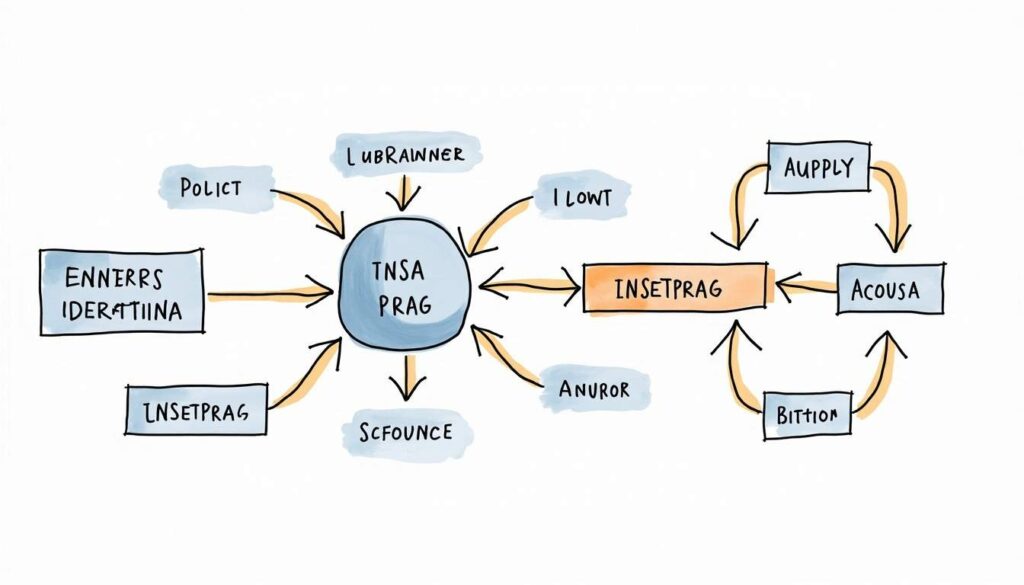Insetprag might not be a household name yet, but it’s quietly becoming a crucial concept in several fields, from software development to data analysis. If you’ve come across the term and wondered what it really means, you’re in the right place. This guide breaks down everything you need to know about Insetprag-what it is, how it works, and why it matters.
What Is Insetprag?
At its core, Insetprag is a method or approach used to insert and manage data pragmatically within complex systems. The term itself blends “insert” and “pragmatic,” emphasizing practical, efficient data handling rather than theoretical or overly complicated methods.
Think of Insetprag as a smart way to embed information into a system, ensuring that the data is not only added but also optimized for retrieval, modification, and overall system performance. This approach is especially useful when dealing with large datasets or dynamic environments where data changes frequently. By prioritizing efficiency, Insetprag allows developers to focus on building robust applications that can handle real-time data processing without sacrificing speed or accuracy.
Moreover, Insetprag incorporates techniques such as indexing and caching, which further enhance data retrieval times. These techniques ensure that once data is inserted, it can be accessed quickly and efficiently, making it ideal for applications that require immediate feedback or real-time analytics. As a result, systems employing Insetprag can maintain high performance even as they scale, accommodating increasing volumes of data without a hitch.
The Origins of Insetprag
Insetprag emerged from the need to streamline data insertion processes in software engineering. Early developers noticed that traditional insertion methods often led to bottlenecks, especially as systems scaled. Over time, a more pragmatic approach was devised—one that focused on balancing speed, accuracy, and resource management.
This balance is what sets Insetprag apart from older data handling techniques. It’s not just about getting data into a system but doing so in a way that supports long-term efficiency and adaptability. The evolution of Insetprag can be traced back to the rise of big data and the demand for systems that could handle vast amounts of information without compromising performance. As organizations began to rely more heavily on data-driven decision-making, the need for a reliable and efficient method of data insertion became paramount.
Furthermore, Insetprag has been influenced by advancements in database technologies and programming paradigms. The integration of NoSQL databases, for instance, has provided new avenues for data management, allowing for more flexible and scalable solutions. This adaptability is crucial in today’s fast-paced technological landscape, where businesses must pivot quickly in response to changing market conditions. As such, Insetprag not only reflects a shift in how data is managed but also embodies a broader trend towards more agile and responsive software development practices.
How Insetprag Works
Understanding the mechanics behind Insetprag requires looking at its core principles. Unlike simple insertion methods that treat data as static, Insetprag treats data as part of a living ecosystem. This means it accounts for context, dependencies, and potential future changes.

Context-Aware Insertion
One of the defining features of Insetprag is context awareness. When inserting data, the system evaluates where and how the data fits within the existing framework. This might involve checking for conflicts, redundancies, or opportunities to link data more meaningfully.
For example, in a customer relationship management (CRM) system, Insetprag doesn’t just add a new contact blindly. It assesses whether the contact already exists under a slightly different name, merges duplicate entries, and connects the contact to relevant sales records. This reduces clutter and improves data integrity.
Moreover, context-aware insertion extends beyond mere duplication checks. It can analyze the relationships between different data entities, allowing for more nuanced interactions. For instance, if a new lead is added, Insetprag can automatically suggest potential connections to existing clients based on shared attributes or previous interactions, fostering a more integrated approach to relationship management.
Dynamic Adaptability
Insetprag systems are designed to adapt as conditions change. If data structures evolve or new types of data need to be incorporated, Insetprag methods adjust insertion strategies accordingly. This flexibility prevents the system from becoming outdated or inefficient over time.
Imagine a social media platform that constantly updates its data models to include new user interaction types. Insetprag allows the platform to insert these new data points without disrupting existing functionalities.
This adaptability is crucial in fast-paced environments where user behavior and data requirements can shift rapidly. For example, during a major event or trending topic, Insetprag can seamlessly integrate real-time data streams, such as user-generated content or engagement metrics, ensuring that the platform remains relevant and responsive to its audience’s needs.
Efficiency and Performance
Speed matters, especially when dealing with massive volumes of data. Insetprag optimizes insertion processes to minimize latency and resource consumption. This often involves intelligent batching, prioritizing critical data, and leveraging indexing techniques.
In practice, this means that even during peak usage times, systems using Insetprag can handle data insertion smoothly without slowing down user experiences or backend operations.
Additionally, Insetprag employs advanced caching mechanisms to further enhance performance. By temporarily storing frequently accessed data, the system can reduce the need for repetitive database queries, leading to faster response times. This is particularly beneficial in scenarios where real-time analytics are essential, such as e-commerce platforms that need to track inventory levels and customer preferences simultaneously.
Applications of Insetprag
Insetprag isn’t limited to one industry or use case. Its principles apply wherever data needs to be inserted efficiently and intelligently. Here are some key areas where Insetprag shines.

Software Development
Developers use Insetprag to manage code changes, configuration updates, and user-generated content. By applying pragmatic insertion methods, software can evolve without introducing bugs or performance issues.
For example, in continuous integration/continuous deployment (CI/CD) pipelines, Insetprag helps automate the insertion of code patches and updates while maintaining system stability.
Database Management
Databases benefit from Insetprag by reducing redundancy and improving query performance. When new records are added, Insetprag ensures they fit logically within existing tables and relationships.
This approach is particularly valuable for relational databases and NoSQL systems that handle complex, interconnected data.
Data Analytics
Analysts rely on clean, well-structured data for accurate insights. Insetprag supports this by ensuring that incoming data streams are integrated thoughtfully, preserving quality and context.
For instance, in real-time analytics platforms, Insetprag methods enable seamless insertion of streaming data without compromising analysis speed or accuracy.
Content Management Systems (CMS)
Content creators and managers use Insetprag to insert articles, images, and multimedia into websites or applications. The approach helps maintain consistency, avoid duplication, and optimize content delivery.
This is crucial for large-scale websites where thousands of new content pieces are added regularly.
Benefits of Using Insetprag
The advantages of adopting Insetprag extend beyond mere data insertion. It transforms how systems handle information, leading to better outcomes across the board.
Improved Data Quality
By checking for duplicates, inconsistencies, and context, Insetprag enhances the overall quality of data. This reduces errors and increases trust in the system’s outputs.
Scalability
Insetprag’s adaptable nature means systems can grow without hitting insertion bottlenecks. Whether the data volume doubles or multiplies tenfold, Insetprag methods keep things running smoothly.
Resource Optimization
Efficient insertion reduces unnecessary processing and storage overhead. This saves computing resources and lowers operational costs.
Enhanced User Experience
For end-users, Insetprag means faster, more reliable systems. Whether it’s a faster-loading app or more accurate search results, the benefits are tangible.
Challenges and Considerations
No approach is without its challenges, and Insetprag is no exception. Understanding potential pitfalls helps in implementing it effectively.
Complexity in Implementation
Insetprag requires careful planning and sometimes sophisticated algorithms to handle context and adaptability. This can increase development time and require specialized expertise.
Balancing Speed and Accuracy
While Insetprag aims for efficiency, there’s often a trade-off between how fast data is inserted and how thoroughly it’s checked. Finding the right balance depends on the specific use case.
Maintaining Flexibility
Systems must be designed to evolve without breaking Insetprag processes. This requires ongoing maintenance and updates, which can be resource-intensive.
How to Get Started with Insetprag
Implementing Insetprag doesn’t have to be overwhelming. Here’s a straightforward approach to begin integrating its principles into your projects.
Assess Your Current Data Insertion Processes
Start by analyzing how data is currently inserted and managed. Identify pain points like slow insertions, data duplication, or errors.
Define Clear Objectives
What do you want to achieve with Insetprag? Faster processing? Better data quality? Scalability? Clear goals guide your implementation strategy.
Choose the Right Tools and Technologies
Many modern databases and software frameworks support advanced insertion techniques. Look for those that facilitate context-aware and dynamic data handling.
Develop and Test Incrementally
Implement Insetprag principles in stages. Test each phase thoroughly to ensure the system behaves as expected without introducing new issues.
Monitor and Optimize Continuously
Insetprag is not a set-it-and-forget-it solution. Regular monitoring helps catch emerging problems and opportunities for improvement.
Future Trends in Insetprag
As data grows in volume and complexity, Insetprag will continue evolving. Emerging technologies like artificial intelligence and machine learning are poised to enhance its capabilities.

AI-Driven Context Awareness
Machine learning models can analyze data patterns and context more deeply than traditional algorithms. This will make Insetprag even smarter, enabling more precise insertion decisions.
Automation and Self-Optimization
Future systems might automatically adjust insertion strategies based on real-time performance metrics, reducing the need for manual tuning.
Integration with Edge Computing
As edge devices generate more data, Insetprag methods will adapt to insert data efficiently at the network’s edge, minimizing latency and bandwidth use.
Conclusion
Insetprag offers a practical, forward-thinking approach to data insertion that addresses many challenges of modern systems. By focusing on context, adaptability, and efficiency, it ensures that data is not only added but integrated in ways that support long-term success.
Whether you’re a developer, data analyst, or system architect, understanding and applying Insetprag principles can significantly improve how your systems handle data. The journey might require effort and expertise, but the payoff in performance, quality, and scalability is well worth it.


